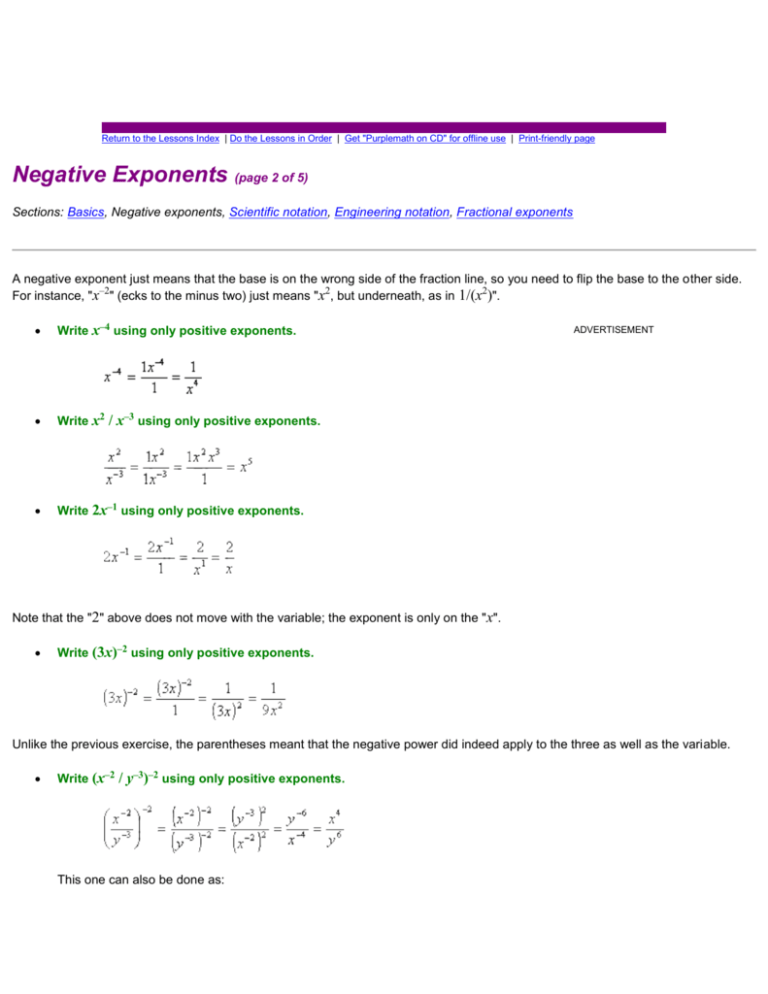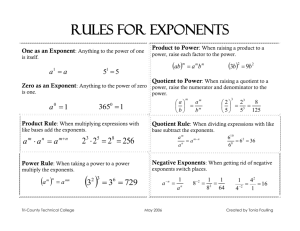
Return to the Lessons Index | Do the Lessons in Order | Get "Purplemath on CD" for offline use | Print-friendly page
Negative Exponents (page 2 of 5)
Sections: Basics, Negative exponents, Scientific notation, Engineering notation, Fractional exponents
A negative exponent just means that the base is on the wrong side of the fraction line, so you need to flip the base to the other side.
For instance, "x–2" (ecks to the minus two) just means "x2, but underneath, as in 1/(x2)".
Write x–4 using only positive exponents.
Write x2
Write 2x–1 using only positive exponents.
ADVERTISEMENT
/ x–3 using only positive exponents.
Note that the "2" above does not move with the variable; the exponent is only on the " x".
Write (3x)–2 using only positive exponents.
Unlike the previous exercise, the parentheses meant that the negative power did indeed apply to the three as well as the variable.
Write (x–2
/ y–3)–2 using only positive exponents.
This one can also be done as:
Copyright © Elizabeth Stapel 2000-2011 All Rights Reserved
Since exponents indicate multiplication, and since order doesn't matter in multiplication, there will often be more than one sequence of
steps that will lead to a valid simplification of a given exercise. Don't worry if the steps in your homework look quite different from the
steps in a classmate's homework. As long as your steps were correct, you should both end up with the same answer.
By the way, now that you know about negative exponents, you can understand the logic behind the "anything to the power zero" rule:
Anything to the power zero is just
"1".
Why is this so? There are various explanations. One might be stated as "because that's how the rules work out." Another would be to
trace through a progression like the following:
35 = 36 ÷ 3 = 36 ÷ 31 = 36–1 = 35= 243
34 = 35 ÷ 3 = 35 ÷ 31 = 35–1 = 34= 81
33 = 34 ÷ 3 = 34 ÷ 31 = 34–1 = 33= 27
32 = 33 ÷ 3 = 33 ÷ 31 = 33–1 = 32= 9
31 = 32 ÷ 3 = 32 ÷ 31 = 32–1 = 31= 3
Then logically 30
= 31 ÷ 31 = 31–1 = 30 = 1.
A negative-exponents explanation of the "anything to the zero power is just 1" might be as follows:
m0 = m(n – n) = mn × m–n = mn ÷ mn = 1
...since anything divided by itself is just
"1".
Another comment: Please don't ask me to "define" 00. There are at least two ways of looking at this quantity:
Anything to the zero power is "1", so 00
Zero to any power is zero, so 00 = 0.
= 1.
As far as I know, the "math gods" have not yet settled on a "definition" of 00. In fact, in calculus, "00" will be called an "indeterminate
form". If this quantity comes up on class, don't assume: ask your instructor what you should do with it.
Lesson Laws of Exponents: Zero and
Negative Exponents
Algebra -> Algebra -> Exponents -> Lesson Laws of Exponents: Zero and Negative Exponents
Log On
Ad: Algebrator™ solves your algebra problems and provides step-by-step explanations!
Ad: Algebra Solved!™: algebra software solves algebra homework problems with step-by-step help!
Algebra: Exponents and operations on exponents SolversLessonsAnswers archiveQuizIn Depth
This Lesson (Laws of Exponents: Zero and Negative Exponents) was created by
by rapaljer(4650)
: View Source, Show
About rapaljer: Retired Professor of Mathematics from Seminole State College of Florida
after 36 years.
This text was imported
fromhttp://www2.seminolestate.edu/rrapalje/BasicAlgebra/Basic%20One%20Ste
p%20Ch%202/2.13%20Zero%20and%20Negative%20Exponents.htm by its
author.
2.13
from Basic
Negative and Zero Exponents
Algebra: One Step at a Time © 2002-2011
P. 215-226
Dr. Robert J. Rapalje
Seminole State College of Florida
ANSWERS TO ALL EXERCISES ARE INCLUDED AT THE END OF THIS PAGE
To see selected solutions in Living
COLOR
click here!
i
Negative Exponents: Learn Them with a Pattern!
What about if the base is negative? How is (-3)-2 done?
Follow the same principle as above. Divide by -3 at each step.
The sign of the answers alternates.
(-3)3 = -27
(-3)2 = 9
(-3)1 = -3
(-3)0 = 1
(-3)-1= -1/3
(-3)-2 = 1/9
(-3)-3 = -1/27
(-3)-4 = 1/81
Or, you can use the definition:
(-3)-2 = 1/(-3)2 = 1/9
(-3)-3 = 1/(-3)3 = 1/(-27) = -1/27 etc.
Are there any games you can play with the concept of negative exponents
once the kids have grasped it?
I have not found any games on this on the internet (let me know if you have
one!). Here are some simple suggestions for a game to make at home
Make problem cards and answer cards, and play a memory game.
Have one stack of cards that would give you the base, and another stack of
cards that would give you the exponent. Then take any board game where you
can roll the dice and advance your peg from a beginning to some kind of goal.
Play so that at each turn you first take one card from the 'base' stack and one
card from the 'exponent' stack, and if you answer right, then you can roll the
dice and get somewhere. Or make up your own rules based on the original
board game.
Or play the other way round: have a stack that has 'answer' cards, numbers
like 1/9, 1/8, 1/25, 1, 4, 1/125, 1/32, 32, 16, 36, etc. and use those in the board
game (some would have positive exponents).
This is a game involving negative exponents. You can give pairs of students
the ace through 5 cards from a regular deck of cards. Black cards are positive
and red cards are negative. One student turns over the base and the other
turns over the exponent (at the same time). Then it is a race to see which
student can call out the correct answer first. Whomever does, collects the
cards. If it is a tie, the cards stay off to the side and the winner of the next
round gets those too. The winner is the student who collects all the cards.
1
What about if the base is a fraction? How is
( )
-2
done?
5
Finding a negative power of a fraction is not something you'd necessarily
present first time studying negative exponents. But here go:
You can again look for a pattern when charting the different powers of 1/5.
1
( )4 =
5
1
( )3 =
5
1
( )2 =
5
1
( )1 =
5
1
1
×
5
1
×
5
1
5
1
×
5
5
625
1
=
5
1
×
1
=
5
1
×
5
1
1
×
125
1
=
5
25
1
5
1
( )0 = 1
5
You will see that each successive step down is like multiplying by 5. Why?
Because if you follow the idea above, you would be
1
dividing by
at each step. Now, you should be aware from
5
fraction division that if you divide any number by 1 , it is the same
5
1
as multiplying the number by the reciprocal of
, which is 5.
5
So dividing by 1/5 is the same as multiplying by 5 Continuing the chart:
1
( )2 =
5
1
( )1 =
5
1
1
×
5
1
=
5
25
1
5
1
( )0 = 1
5
1
( )-1 = 5
5
1
( )-2 = 25
5
1
( )-3 = 125
5
1
( )-4 = 625
5
Or, you could use the definition, which says to take the reciprocal of the
number raised to the positive exponent. So for example,
1
( )-2 = 52 = 25
5
1
( )-6 = 56 = 15625
5
2
3
3
( )-3 = ( )3 =
3
2
2
9
3
×
2
3
×
2
7
(1 )-4 = ( )-4= ( )4=
7
7
9
27
=
2
8
7
7
×
9
3
=3
8
7
×
9
7
×
9
2401
=
9
6561
Why is the answer to any digit with the exponent of zero equal one. (The theory not
just because it is)
Jose Gonzalez
Please see Two proofs that a number to zero exponent is one. Actually you can
also plain DEFINE n0 to be 1, and then give the "proofs" presented in that article as
justifications why we should define it so - it is the only reasonable definition that
makes it work with the laws of exponents.
Please see also n^0 Power = 1: Defined or Proved?
More information:
Are Negative Exponents Like Other Exponents?
Is there a general rule for doing all exponents, or does a negative exponent have
nothing in common with positive exponents?
n to 0 power
Why any number raised to the zero power is equal to one.
Decimal Exponents
Can you have exponents that are decimals?
Meaning of Irrational Exponents
But where do irrational exponents fit in? Can you raise 2 to the sqrt(2) power? Is there
any definition for this?





